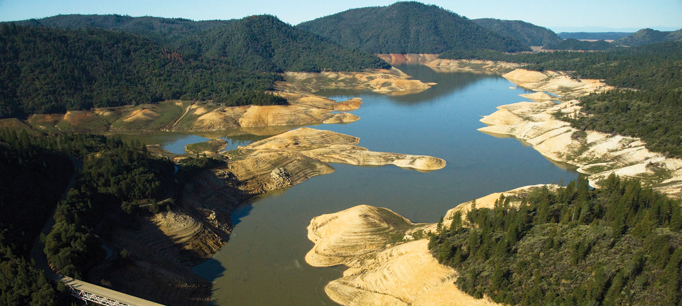This is part of a continuing series on the impact of the drought.
The severity of the current drought is sparking keen interest in seeing how this past water year (October 2013–September 2014)—and more importantly, the past combination of years—ranks in comparison to other droughts. As noted in a PPIC fact sheet, this drought is one of the driest.
 What’s more, this drought is so challenging because it has been very warm. Recent summaries from the National Climatic Data Center reveal that the 2014 water year was one of California’s warmest, as the map below indicates. The numbers show how average temperatures for the past water year compare over 119 years of record-keeping. Much of the west was warm—and California was warmest of all.
What’s more, this drought is so challenging because it has been very warm. Recent summaries from the National Climatic Data Center reveal that the 2014 water year was one of California’s warmest, as the map below indicates. The numbers show how average temperatures for the past water year compare over 119 years of record-keeping. Much of the west was warm—and California was warmest of all.
In addition, the 2014 water year was preceded by two drought years with daily average temperatures and daily maximum temperatures that were well above the 20th century average.
Temperature plays an important role in exacerbating water scarcity during drought. Warm temperatures during the winter and spring reduce the amount of snow relative to rain and lead to earlier spring snowmelt. The state’s snowpack is our largest surface reservoir, accounting for roughly a third of available supply.
Warm temperatures have an equally important impact on how much water is lost to the atmosphere by transpiration of plants and evaporation from soils. In a typical year, this process—called evapotranspiration—removes almost two thirds of the water that falls on the state. Warmer temperatures and a longer growing season dry things out, sharply reducing the share of rainfall that makes it into rivers and groundwater.
 As soils dry out, it is harder to recover when the rains come again. The parched landscapes of California will require abundant rain this winter before soils become saturated enough to produce significant runoff. This is why runoff, relative to the amount of precipitation, is often less following very dry years. Even if we receive normal precipitation this winter, we will still have a drought “hangover” (see recent forecasts for the coming winter).
As soils dry out, it is harder to recover when the rains come again. The parched landscapes of California will require abundant rain this winter before soils become saturated enough to produce significant runoff. This is why runoff, relative to the amount of precipitation, is often less following very dry years. Even if we receive normal precipitation this winter, we will still have a drought “hangover” (see recent forecasts for the coming winter).
Finally, it is worth noting that most climate change models suggest that the well-documented decades-long trend toward warmer temperatures in California will continue (models are less certain about changes in precipitation amount). More years that are both dry and warm will pose many challenges for California, as we can see from our struggles with the current drought.


